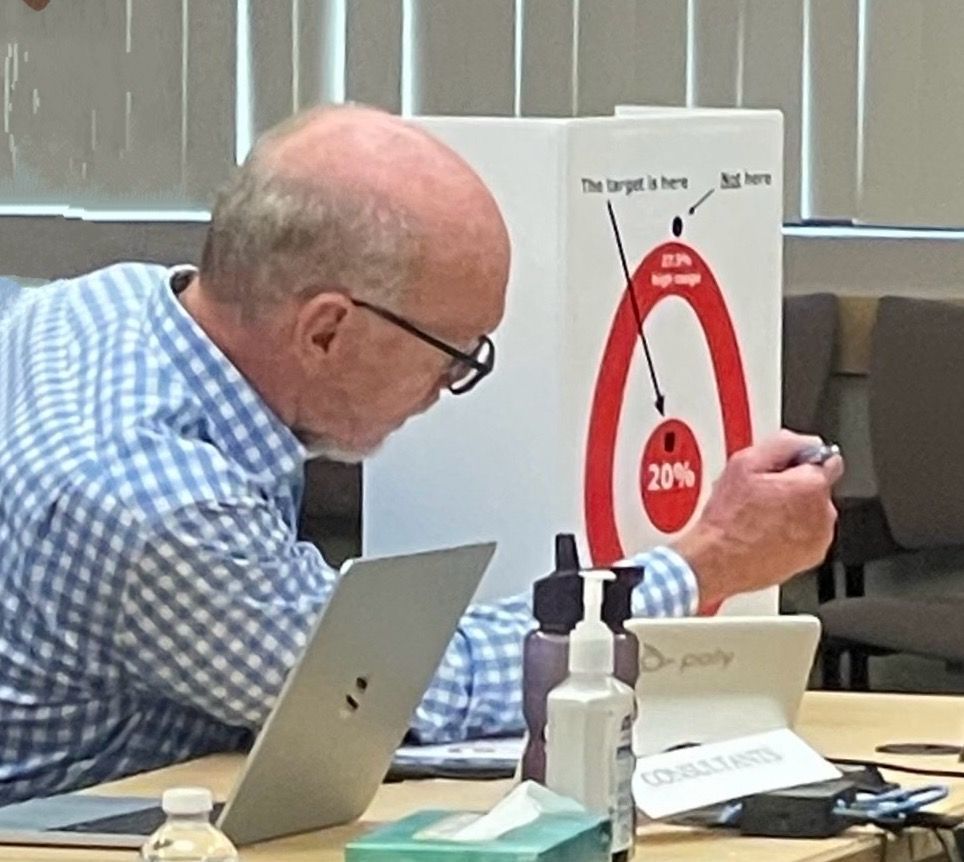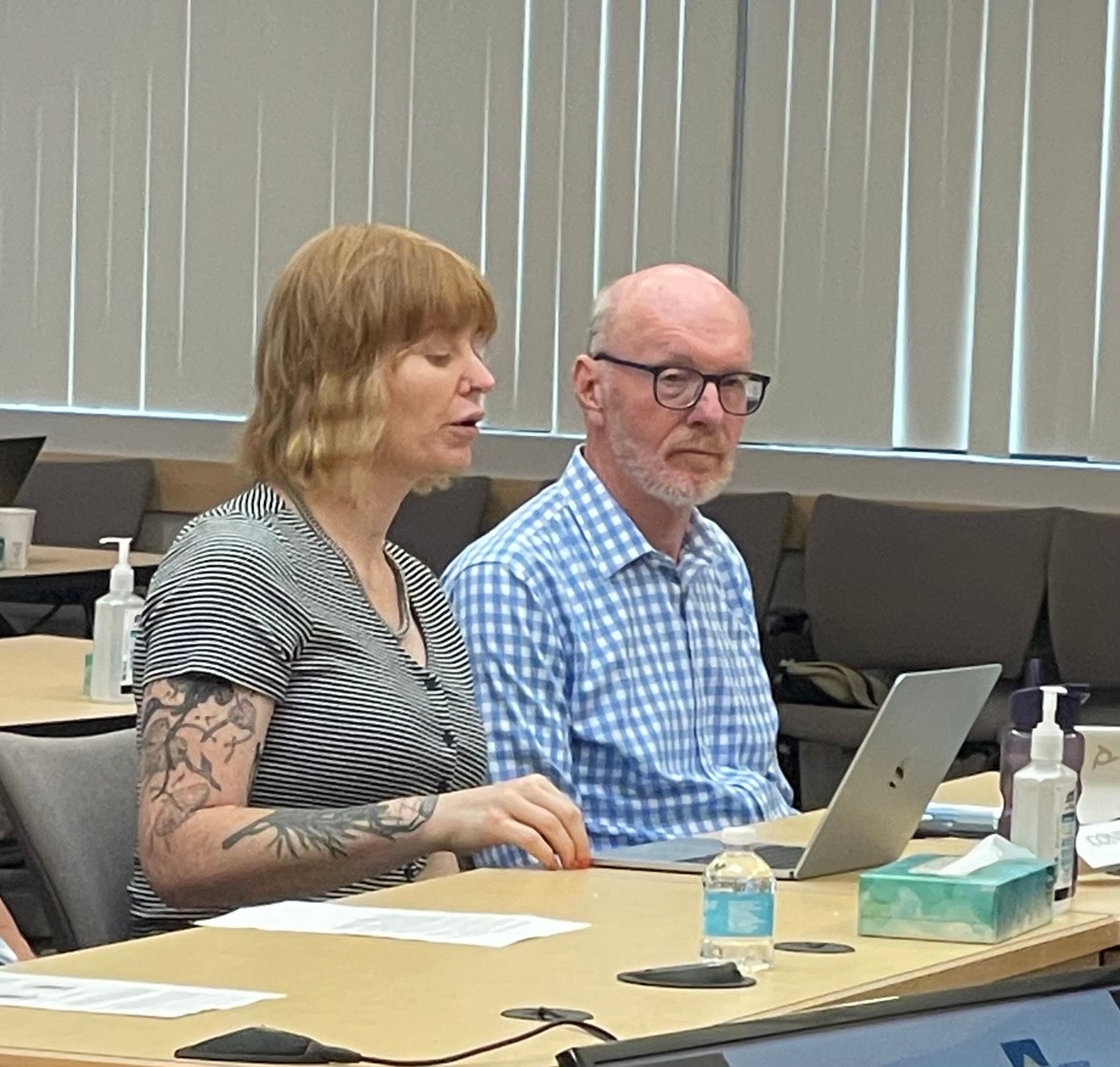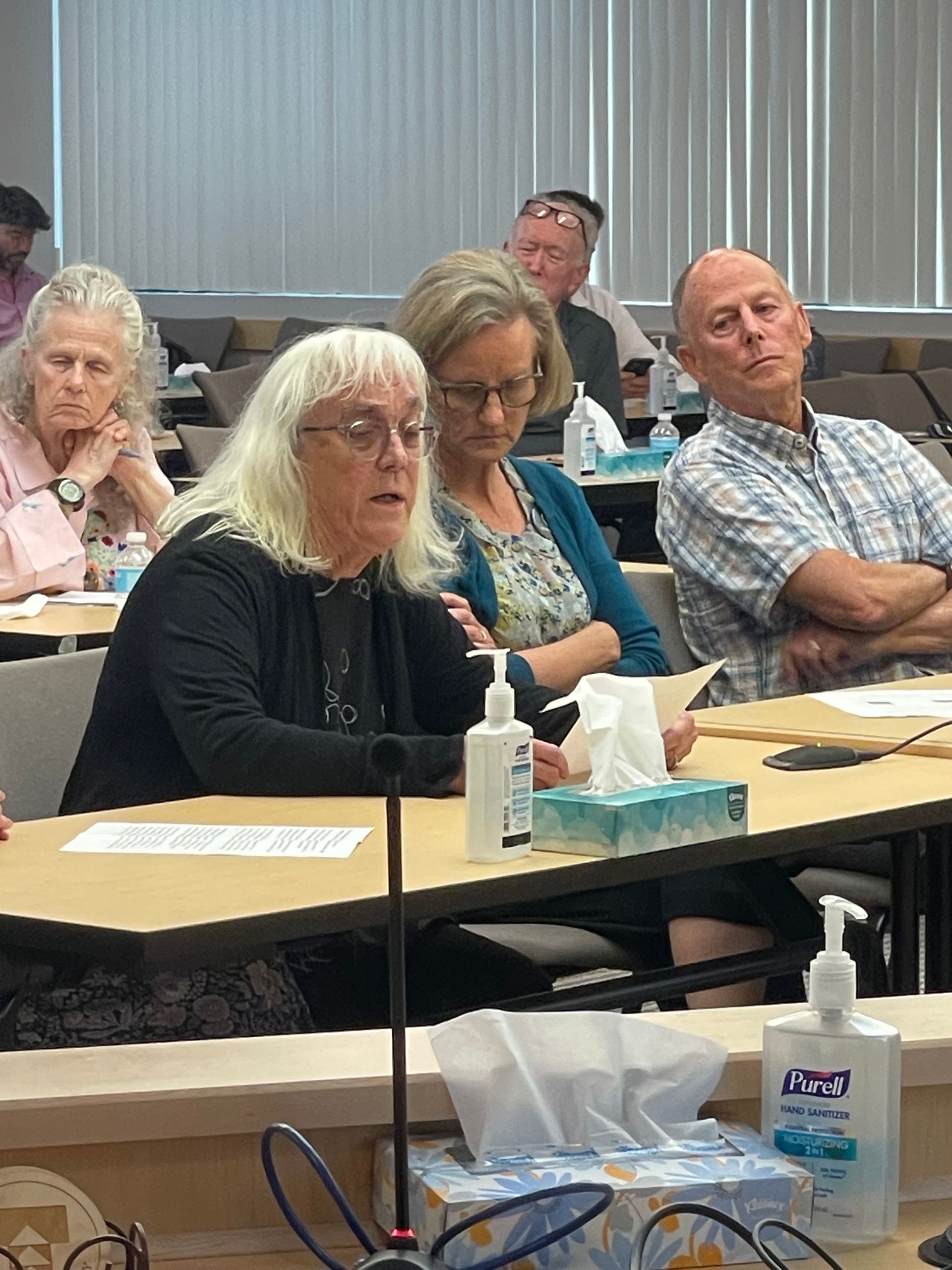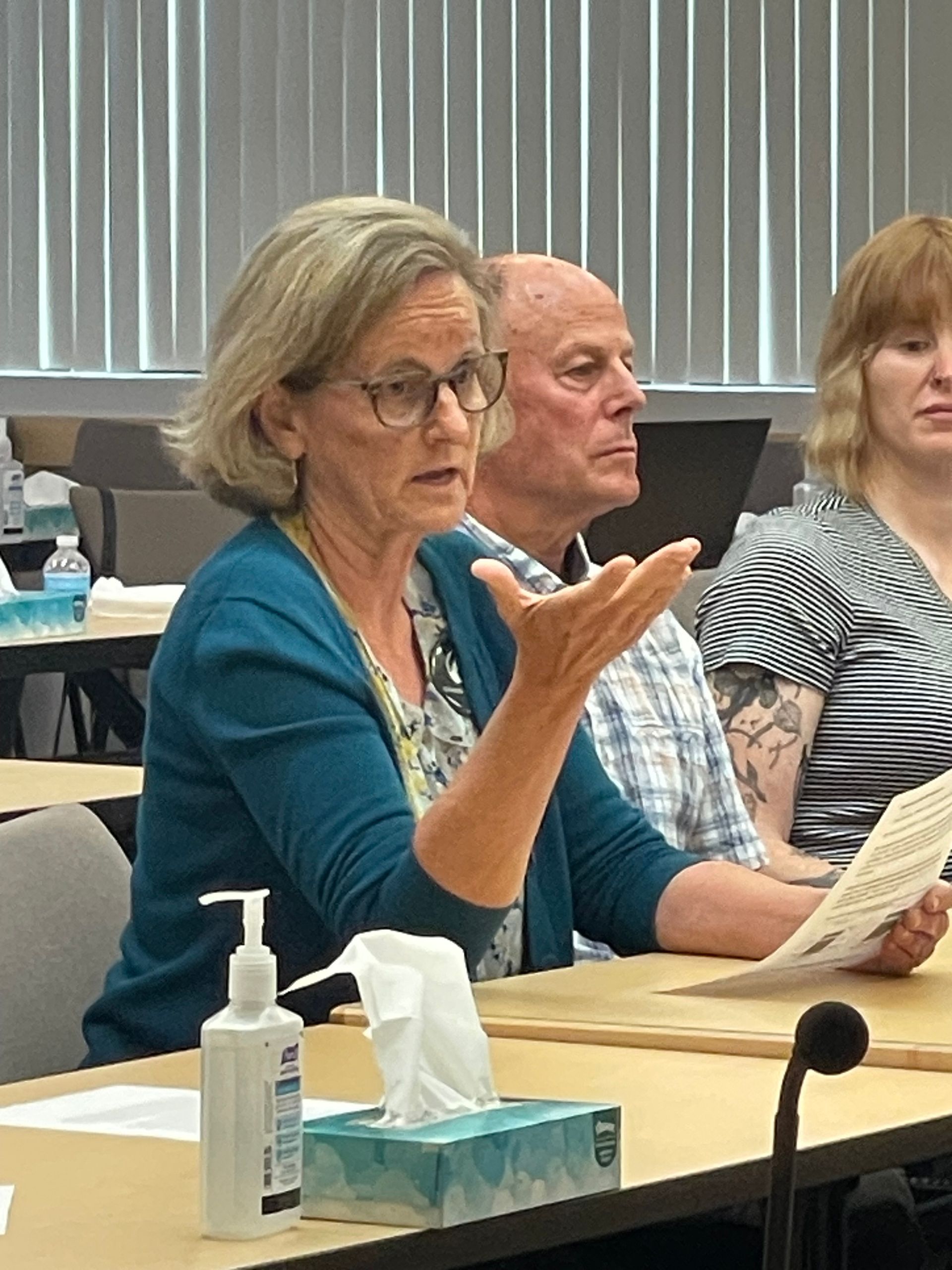Divest Oregon Sends Clear Message at Oregon Investment Council Meeting
September 4, 2025
At the September 3rd Oregon Investment Council (OIC) meeting, Divest Oregon members made strong statements about the need to curb private investments. Risky, illiquid,
high-fees and low-returns investments obscure a lot of the emissions that PERS is funding - and are difficult to divest in times when the need to be nimble is more critical than ever. You can read some of the testimony about
AFT-Oregon’s Harper Haverkamp spoke of concerns of 17,000 members that are reflected in the recent AFT/AAUP National report. This report calls out pension funds’ private investments as antithetical to AFT’s values.
Nichole Heil, from Private Equity Stakeholder Project, traveled from California to speak about the climate devastation and financial risk of two private investments made by the Oregon Treasury.
More media coverage is showing up around the state about private investments at the Oregon Treasury. See the
September 2 article from Willamette Week
and the Oregon Journalism Project entitled, “More Questions Arise About State Investments in Private Equity.”

Oregon Treasury Investment Team Causes $3.7 billion loss to PERS Retirement Fund since 2023. Treasury staff disregarded policies limiting private equity investments. Overview A Divest Oregon analysis of Oregon Treasury private equity investment practices finds that years of exceeding the Oregon Investment Council’s (OIC) policy limiting high-risk private equity significantly reduced the performance of the Oregon Public Employees Retirement Fund (OPERF). These effects total about $3.7 billion in reduced value since 2023 . At the center of this issue is Oregon Treasury Chief Investment Officer Rex Kim and his investment team , whose long-term private equity acquisitions significantly exceeded OIC’s risk tolerance for OPERF as stated in its investment policy targets. The OIC is a trustee , and an agent’s failure to follow a trustee's instructions is a breach of trust . These events raise broader questions about policy oversight, internal accountability, and the Treasury’s ability to align its investment practices with new directives under the Oregon Climate Resilience Investment Act (CRIA) . Policy Departures and Oversight Challenges Since at least 2019, OPERF’s investments in private equity substantially went over the levels established in OIC’s policy targets. Corresponding reductions in lower-risk public equity went well below target. While the OIC sets investment targets, it relies on Treasury investment staff to implement them faithfully. By 2022, excessive amounts of private equity led to urgent pressure within OPERF to obtain cash for PERS benefit payments. Treasury then undertook substantial sales of public equities. During this time, the CIO argued ( audio at 1:26:40) that OIC’s private equity policy target was just “some 20 per cent artificial number” and existing overinvestments in private equities should continue. His remark highlights the continuing tension between policy set by the OIC and its implementation by Treasury leadership. Documented Financial Impact In 2025, the Oregon Journalism Project reported that Treasury’s overinvestment in private equity reduced OPERF’s exposure to better-performing public equities and caused $1.4 billion in lost value during 2024 alone. Treasury officials did not contest the reported dollar loss, although Treasurer Elizabeth Steiner noted that a single-year snapshot cannot fully capture the long-term effects of complex portfolio dynamics. Nonetheless, she acknowledged in October 2025 the need to rebalance OPERF’s exposure away from private equity toward more liquid, lower-risk assets. Broader Review by Divest Oregon Following Oregon Journalism Project reporting, Divest Oregon conducted an independent examination of Treasury’s investment return statements from January 2020 through the third quarter of 2025. Impacts were calculated by looking at investment yields as they would have been had the Treasury leadership followed OIC policy targets, and comparing them with the yields that Treasury reported. The analysis confirmed the substance of the Oregon Journalism Project’s finding of a $1.4 billion underperformance in 2024, and identified additional damage to OPERF returns totaling $2.3 billion for 2023 and 2025. Divest Oregon’s Chart 1 shows these underperformances resulted in cumulative damage of $3.7 billion to OPERF returns since 2023. Had Treasury met the OIC targets, Divest Oregon calculates that OPERF’s total returns would have increased by 1% to 1.5% annually in 2023 and 2024, improving the system’s funded ratio in 2024 by roughly 1% , from 73% to 74%.

Ted Siedle, self described as America's leading forensic expert investigating pension and retirement plans, has as his mission to prepare you to fight to protect the retirement benefits you were promised. You can read his Substack columns here . This is his recent column named, "Business School Students Seize Opportunity To Learn About Public Pension Mismanagement" ( published 11/3/2025 ). The following is a lecture that was given to participants in Florida Atlantic University’s Executive Education program on Saturday November 1st. Attendees were introduced to the secretive world of America’s state and local public pensions, invited to participate in an ongoing investigation of the nation’s largest state pension (California Public Employees Retirement System) and begin a lifelong course of learning about the mismanagement at these massive plans. Introduction Hello, my name is Edward Siedle and, over the past 20 years, I have conducted forensic investigations into fraud and mismanagement of well over $1 trillion in primarily retirement plans. My past investigations have exposed profound problems at the massive state pensions of Rhode Island, North Carolina, Ohio, and Minnesota, as well as cities such as Jacksonville, Nashville, Chattanooga, Longboat Key, Jupiter and Delray Beach. Other investigations of financial fraud I’ve undertaken—the findings of which have not been made public—have resulted in the largest federal whistleblower awards in history. I am currently conducting an investigation of the largest state pension in America, the $550 billion California Public Employees Retirement System—a pension which over 2 million California state workers and their families depend upon for their retirement security. The CalPERS investigation and my earlier investigations will be the subject of an upcoming documentary film—the official trailer for which should be released very soon. Today, I’m inviting those of you in the lecture hall and others listening remotely to become involved in our current half-trillion-dollar CalPERS investigation and this emerging field of pension investment forensics. I’m inviting you to become involved in our CalPERS investigation and this emerging field of pension investment forensics. I am the only person in the world—the only person—who has ever conducted forensic investigations of any of our nation’s massive state and local investment funds. And that is the problem. It is a serious problem—one I hope to begin to end today by inviting all of you who are looking for a challenge to get involved in solving. These days when I’m asked to explain what I do for a living—in terms anyone can understand—I say: “It’s like the television show CSI: Miami. Each episode of the show typically opens with the discovery of a dead body and the job of the forensic investigators is to figure out whether the death was due to natural causes or foul-play. In my work, the “death” I’m investigating is a dead, or seriously sick, pension or investment. The question is, did the investment fail—was the money lost—due to natural causes (such as an unforeseen decline in the stock markets), or was there foul-play? The wrongdoing I look for is undisclosed conflicts of interest, hidden and excessive fees or outright violations of law. More often than the public or even victims ever imagine, the damage is caused by wrongdoing– unethical Wall Street advisers who drain client accounts for their own benefit.” The wealth of the hard-working gets transferred to the wealthy, hardly-working on Wall Street. How Big Is The Problem of Investment Fraud? Forensic and fraud accounting experts estimate that the cost of fraud globally amounts to trillions annually. They’re wrong. Based upon my experience, the true figure is exponentially greater. The overwhelming majority of investment scamming is not included in global estimates because fraud experts with accounting backgrounds are not trained to identify the myriad forms of scamming and aren’t looking for it. They don’t understand Wall Street corrupt business practices—abuses which are ever-evolving. My estimate—based upon decades of experience—is that well over half of all investing involves scamming of one sort or another. In my book, How To Steal A Lot of Money—Legally, I teach readers the tricks investment scammers at the highest levels play because I believe there is great value in learning how to steal. Why? Because lying, cheating, and stealing are so commonplace in life generally, and in the world of investing especially, that they are not the exceptions. Scamming mercilessly overwhelms any so-called rules and devours those who play by them. … there is great value in learning how to steal. So, learning the “rules” without learning the even greater larcenous “exceptions” makes no sense—it’s reckless. Schools and professors who teach the “rules” alone are negligent, in my opinion and put students, at a minimum, at a competitive disadvantage, or, worse still, in harm’s way. For the student of investing, the choice is simple—either study bad behavior and be forewarned, or risk losing everything you own. Now, let’s return to the “opportunity” I’m here to present to you. America’s Public Pensions Basically, there are two types of pensions—private or corporate pensions and then there are public or government pensions. We’re going to be focusing upon public pensions. In America today, there is over $6 trillion in state and local government retirement funds securing over $7 trillion in pension liabilities. There are over 5,000 public sector retirement systems. Here in Florida alone, in addition to the $220 billion state system, there are approximately 500 local pensions and some cities run multiple plans for general workers, police and firefighters. America’s public pensions have supposedly set aside 80 cents, on average, to pay every dollar in retirement benefits they have promised. But this is only if you believe the financial statements they provide. My investigations have all concluded—in every single case I have investigated—the financials are grossly, outrageously and often glaringly wrong. For example, an investigation I concluded last year of the Minnesota state pension system revealed that the state had wildly under-reported the fees it paid to Wall Street advisers managing pension assets. Immediately following my investigation, the pension quietly—without alerting anyone as to the outrageous error—increased the amount of annual fees disclosed by 400% or over $300 million . That was a massive and, to date, unexplained, error. So, in addition to being, at a minimum, over $1 trillion underfunded and lacking financial statements that accurately reflect their assets and liabilities, there’s lots of other obvious structural problems plaguing nation’s public pension systems. America’s public pension problems are so ginormous and the solutions to these problems so simple, that earlier this year I whimsically proposed the creation of a Department of Pension Efficiency, otherwise known as DOPE. The goal of DOPE would be to restore transparency, eliminate wasteful spending, improve investment decision-making and save America $6.5 trillion over the next 30 years. The goal of DOPE would be to restore transparency, eliminate wasteful spending, improve investment decision-making and save America $6.5 trillion over the next 30 years. Let me emphasize: There is no problem facing our nation today that could be so simply fixed and provide such massive savings as our public pensions. So, let me explain why America’s state and local pensions are such a mess and why your help with forensic investigations is so desperately needed. Perhaps because I’m trained as a lawyer, in my bestselling pension book, Who Stole My Pension ? I begin with a discussion about the lack of regulation of these plans. Lack of Effective Regulation While America’s public pension plans—with tens of millions of individuals depending upon them for retirement security—collectively hold over $6 trillion in assets and heavily influence the global markets, these pensions remarkably are not protected by any comprehensive federal, or state law. Again, there is no comprehensive law. The Employee Retirement Income Security Act of 1974 (ERISA), a federal law that sets rigorous standards for most private-sector (corporate) retirement plans in the United States, does not apply to public pensions. Since public pensions are exempt from ERISA, participants in these funds lack many key federal safeguards that private-sector workers in corporate retirement plans typically enjoy. Another problem with state and local pensions in the United States is that no federal or state regulator, or law enforcement agency, actively monitors or polices these plans. State Attorneys General (AG) prosecute public pension matters only rarely — and usually only in cases of serious misconduct, clear fraud or corruption, or political scandal where public pressure demands it. Routine mismanagement, underfunding, or poor investment decisions almost never trigger prosecution, even if they cause long-term harm. Lack of Board Oversight Now, let’s talk about lack of effective board oversight. Remarkably, board members overseeing $6 trillion in the nation’s thousands of public pensions are not required to have any professional investment expertise, and most do not have investment backgrounds. The majority are elected from within public-sector employee groups and have backgrounds in labor, education, or public administration. What could possibly go wrong, you might ask? Everything and far more than you can imagine. Would you believe criminal convictions, suicides, hookers and blow. By way of example, take a peek at the California Public Employees Retirement System, America’s largest state pension we’re currently investigating. For years the pension had been considered the “gold standard” for its investment approach, its integrity and its management. How well has the nation’s “best of the best” public pension been managed over recent years? In 2016, the former chief executive of the pension was sentenced to a prison term of 4.5 years after pleading guilty to a conspiracy charge for taking more than $250,000 in cash and other bribes from his friend and former CalPERS board member Alfred Villalobos. Prosecutors said Villalobos, who killed himself weeks before he was due to stand trial, reportedly made $50 million as a middleman for investment firms looking to get a piece of the massive pension’s business. Later that same year, a former director of New York’s multibillion dollar public pension was charged with accepting crack cocaine, money for prostitutes and other lavish bribes to steer more than $2 billion in securities trades. That’s right: Hookers and blow at America’s state pensions. Add that to your “WTF” file. How Politics Influence Public Pensions Unlike corporate pensions, public pensions are political entities, not simply rational investors. While these pensions are long-term financial commitments, politicians have short-term election cycles, face pressure to deliver immediate results (e.g. cut costs or increase benefits) and lack incentive to fully fund systems long after they will be out of office. This misalignment of incentives is one of the root causes of public pension underfunding. Politicians can benefit from public pension investment decisions both directly and indirectly through political influence, patronage, campaign support, or shaping policy agendas. For example, in Florida the state’s $220 billion in pension investments are overseen by a 3-person board consisting of the Governor, Attorney General and Chief Financial Officer—none of whom have pension investment experience and all of whom may receive campaign funding from Wall Street firms seeking pension contracts. Does politics influence public pension investment decisions in Florida and across the nation? What do you think? To recap: As a result of lack of comprehensive federal oversight, severely limited board expertise and political interference, public pensions are often referred to by prominent financial journalists and academics as the “dumbest investors in the room” —easily exploited by more sophisticated, richly compensated Wall Street players. Public pensions are considered the “dumbest investors in the room” by Wall Street. What About Transparency? Thanks to the internet and state public records laws (often referred to as “Freedom of Information Act” or “FOIA” laws), participants in America’s public pensions have more immediate access to pension information more than ever. On the other hand, Wall Street investment firms have in recent years devised the most secretive investments in history—schemes designed to conceal outrageous fees, risks, unethical and even illegal practices—specifically to thwart public scrutiny. Worse still, our public pensions have loaded-up —as much as nearly 60%-- on these private investments—not subject to public scrutiny—which Wall Street promises will outperform the stock market and solve any pension underfunding woes. So, note: Two opposing forces are at work here: technology facilitating transparency versus finance industry legal machinations to thwart transparency. Remarkably, Wall Street is winning and the public is losing the transparency battle as the Information Age has evolved into the Age of Intelligence or AI. Nevertheless, virtually all state and local government pensions today have websites that disclose key information relating to the investments, such as the asset allocation, performance, investment managers and fees—i.e., information generally required under state access to public records laws. I invite you all to go to https://calpers.ca.gov for information about fund asset values, financial reports and governance documents. At first, you’ll likely be overwhelmed by what’s disclosed but over time you’ll realize much of the most important information is not. Also, wherever you eventually settle after graduating, take some time to become familiar with the website and reports of the state or local pension you’re supporting as a taxpayer. Board meetings are generally open to the public and they hate it when informed members of the public show up and ask hard questions. Go to a board meeting just to piss them off. Failure to Disclose Billions in Fees Paid to Wall Street Public pensions universally lie about how much money they pay Wall Street investment firms to manage their assets. They pay exponentially more—perhaps ten times—than they disclose. In all of my investigations, I have proven the fees public pensions disclose to the public are just the “tip of the iceberg.” Most of this failure to report is due to fee complexity related to so-called private investments, such as private equity and debt. That is, so-called alternative investments, such as hedge, private equity and credit funds impose multiple levels of hefty fees which are not fully disclosed to even to pension boards, much less participants. The problem is exacerbated by the fact: (1) Pension boards lack investment experience and, hence, don’t know how to ferret out fees; and (2) Pension boards have agreed to withhold documents related to fees from participants and the public—so no one has the opportunity to verify whether fees are fully disclosed. For example, in April 2013, I took a quick peek from the sunny beaches of South Florida at the website of the distant —nearly 1500 miles away—$7 billion Rhode Island state pension which led me to immediately conclude that the investment fees the pension was paying to Wall Street were underreported and suddenly skyrocketing. At that time, the total fees disclosed on the state pension’s website was $11 million. By September, three months after I exposed the underreporting in an article I wrote in Forbes, the fees the pension disclosed had mushroomed to $80 million and, since then, the fees have exploded to $188 million. Public Pension Poor Investment Performance So, how do public pensions which, we have observed, lack regulatory oversight, transparency, board expertise and are prone to political interference—often referred to as the “dumbest investors in the room” —perform? How good are their investment results? Over the course of my 40-year career examining thousands of pensions, I have never seen a pension openly acknowledge that its investment performance sucks. Obviously, there have to be some pension laggards but you’d never guess it from reading the glowing performance reports they provide to participants and the public. How can every pension claim to have superior investment results? They lie—or, to put it more kindly, they don’t tell the complete truth. So, whenever presented with investment performance results for a public pension, you should be suspicious. Due to the structural deficiencies we’ve already discussed, almost all public pensions will consistently perform poorly compared to an appropriate benchmark index. Underperformance is inevitable—seemingly unavoidable. Due to the structural deficiencies we’ve already discussed, almost all public pensions will consistently perform poorly compared to an appropriate benchmark index. Underperformance is inevitable—seemingly unavoidable. Thus, public pensions are always searching for ways to make their bad or mediocre performance look stellar. Pensions are assisted in this effort by Wall Street investment consulting firms which have mastered the art of investment performance chicanery. Trust me, the people running any public pension you examine will never, ever admit that they’ve done a bad job. If they did, they’d lose their jobs. Conclusion In closing, I hope this brief introduction to the world of state and local pension investing has opened your eyes to new opportunities. There’s a ton of mismanagement and fraud at these funds that’s costing pension stakeholders hundreds of billions annually. There’s a ton of work to be done here—hopefully before the next Global Financial Collapse. I’ve laid out the opportunity for you. You’ve got plenty of time to think about it—it’s not going away anytime soon. But here’s the craziest ending to this story: Fixing the problem is easy but…… it’s a problem no one wants you to fix. Wall Street, politicians and even unions benefit from the status quo. They don’t want to see these pensions better managed—the investments performing better, at lower costs. My hope is that the more smart, motivated young minds diving deep into these pensions’ operations, exposing mismanagement and raising public awareness, the greater the likelihood that change will come. Wherever you go, whatever you do professionally, don’t forget about the public pension in your backyard.

Two new reports by Divest Oregon highlight the interdependency of lowering fossil fuel investments and a just transition to clean energy. Pension funds seeking to invest in low carbon investments to support climate health must examine the impact of proposed investments on the health and well-being of communities. The Oregon Treasury is committed, by a recently passed Oregon law , to “the goal of reducing the carbon intensity of the [Oregon Public Employees Retirement] fund through a preference for investments that reduce net greenhouse gas emission” while “investing in public equity holdings that incorporate the tenets of a just transition in their overall priorities and portfolio.” Pension fund investments that do not support a just transition present a financial risk to investors. As a United Nations International Labour Organization report explains: A failure to promote a just transition represents a threat to effective climate action, and can contribute to increased inequality and fuel social unrest. This, in turn, can lead to major financial implications for banks and insurance companies as social instability, transition risks and physical climate change impacts may disrupt clients’ business operations due to interruptions in their supply chains, impacts on human health, or loss of livelihoods. In its report, Oregon Treasury’s Investment Screening Failures , Divest Oregon finds that Oregon Treasury’s failure to screen its investments results in investments that worsen the climate crisis, violate people’s rights, cause injury, and cause negative consequences to the Oregon Treasury and its holdings. The report offers examples of the interdependence of climate and investment results. One notable example is the Rio Grande Liquid Natural Gas (LNG) Export Terminal. In December of 2022, OST committed $350 million to GIP Fund V for the project. The 900-acre project was sited on sacred tribal lands without free, prior and informed consent (FPIC) in the face of strong and broad community and global opposition. Construction and operation of the terminal promised to devastate the last deepwater port in the Gulf without fossil fuel projects, and destroy key components of the local community and economy. The risks were financial as well as environmental. Multiple banks and insurers had already withdrawn their support when the Oregon Treasury chose to invest. The project had no FERC permit and was in litigation. GIP’s two previous funds had a history of underperformance. There were numerous indicators that the LNG market would be glutted by the time this project came online. A July 31, 2025 decision by FERC gave a green light to the project. As of September 2025, the earliest projected completion date is 2030. Pipeline and export terminal infrastructure is designed to last for decades with obvious repercussions for the climate and the community. Opposition to the project continues. Divest Oregon’s Just Transition and the Oregon State Treasury report describes the financial benefit to pension funds of investments that promote a just transition to clean energy. Citing the guide for investor action from the Investing in a Just Transition Initiative and United Nations’ Principles for Responsible Investment (UNPRI), it notes 5 reasons why investing in a just transition is in the best interest of beneficiaries and in line with fiduciary duties by: Responding to systemic risks Reinvigorating fiduciary duty Recognizing material value drivers Uncovering investment opportunities Contributing to societal goals The report presents recommendations for a just energy transition for public pension funds. It calls for pension funds to establish investment policies regarding Free, Prior and Informed Consent (FPIC) and Fair Labor Rights and provides a detailed explanation of these principles and their relationship to the financial health of pension funds. Citing examples of pension funds that have successfully utilized the principles of just transition like NYSERS and CalPERS, the report provides a guide for pension funds to adopt ethical and beneficial investment strategies.
Portland, OR - The Oregon Treasury’s Investment Screening Failures report revisits emblematic fossil fuel projects that the coalition identified as “investment failures” in 2023. These projects worsen the climate crisis, cause harm to communities and the environment, and result in negative economic consequences to state employees’ retirement savings that the Oregon Treasury manages. Treasury is invested in these projects either directly through a private equity fund or indirectly through stock ownership. The report argues that the Treasury must urgently adopt more rigorous screening mechanisms to better protect Oregon’s Public Employee Retirement System (PERS) and help advance a more just energy transition . “The core question of the report is: Do fund beneficiaries want their retirement money to fund the climate crisis, community destruction and human rights violations?,” said Jenifer Schramm, co-lead of Divest Oregon and the report’s author. “And, are the beneficiaries aware of the financial risk of these investments? Is the Oregon State Treasury aware of the risks?” In the fall of 2022, the Treasurer pledged a climate focus in the portfolio. A short while later, the Treasury invested hundreds of millions in a private fund dedicated to construction of a massive liquid natural gas terminal on the Texas Gulf Coast. This financially problematic investment raises the question of the Treasury’s investment selection process. The report argues that better screening, more transparency, and less reliance on notoriously secretive private investments would reduce the harm, increase trust among fund beneficiaries, and ultimately produce better returns. “The Investment Screening Failures report challenges the Oregon Treasury to tell the beneficiaries of the fund it manages how investments are chosen and what their retirement funds are supporting,” said Richard Brooks, Climate Finance Program Director of Stand.Earth. “The first Failures report graphically illustrated the fossil fuel industry’s disregard for Indigenous rights and labor rights; its destruction of climate and communities. Two years later the profiled investments look no better – and the Treasury continues to invest in the fossil fuel industry. We’ll be watching to see if the Treasury follows the report recommendations and updates its investment screening and oversight.”

Portland, OR - Following the recent passage of the Climate Resilience Investment Act ( CRIA - HB2081) requiring that Oregon follow a “just transition” for investments in public markets, a new report from Divest Oregon – Just Transition and the Oregon State Treasury – outlines the urgent need and a framework for the Treasury to support a just transition to clean energy. According to the Oregon Just Transition Alliance , a nonprofit coalition of rural, coastal, and urban communities, a just transition is “about moving from a harmful, extractive economy to one that gives more than it takes, heals more than it harms, and allows people and the land to thrive.” The new report from Divest Oregon highlights key considerations as Oregon invests in a clean-energy future, including how the Oregon State Treasury can advance labor rights and the right to free, prior, and informed consent (FPIC) for Indigenous communities. The report offers a wide range of actions that other pension funds are already implementing to safeguard the long-term sustainability of their investments while providing ways to evaluate similar efforts at the Treasury. “Advancing a just energy transition is not only a moral obligation to frontline communities impacted by Oregon’s investments, but now a legal requirement that is backed by sound financial guidance,” said Rory Cowal, lead author of the report and Divest Oregon member. “We hope that this new report will offer initial guidance for the Treasury as they create a roadmap to implement their own ‘just transition’ framework.” The report outlines the financial benefits to pension funds that promote a just transition toward clean energy, citing the guide for investor action from the Investing in a Just Transition Initiative and United Nations’ Principles for Responsible Investment (UNPRI). Pension funds that utilize these frameworks can more effectively respond to systemic risks, uncover unseen investment opportunities, and contribute to societal goals that enhance the health of the wider portfolio. While the Oregon State Treasury has emerged as an early adopter of this just transition framework, other pension funds have already successfully utilized just transition principles, including the New York State Common Retirement Fund (NYSCRF) and the California Public Employees' Retirement System (CalPERS). “Oregon Treasury’s commitment to advancing a just transition puts it in line with national and international leaders,” said Susan Palmiter, co-lead of Divest Oregon. “We hope that this report supports Treasury leadership as they take the critical steps to support a clean energy transition in a way that not only complies with the law but allows Oregonians to more fully benefit from climate-safe, rights respecting investments.”

To respond to a news release by the Treasury that their most recent quarterly returns have been excellent, Divest Oregon publishes this set of charts that focus on the following statements and question: Private equity hasn’t delivered superior performance over the long term to OPERF Treasury staff disregarded OIC private equity policy and invested too heavily for many years OPERF allocations to all forms of high-risk opaque private investments are out of step with peers Can an unreformed Treasury culture be relied on to implement Net Zero policy? A statutorily required OIC complete investment program audit is five years overdue Divest Oregon looks forward to a public statement from the Treasury that addresses these issues and questions.

Treasury’s Love Affair with Private Investments Doesn’t Add Up Two recent, major investigations by The Oregonian and the Oregon Journalism Project in Willamette Week and statewide local newspapers, recently detailed significant problems with the Oregon State Treasury’s private equity overexposure for PERS. Following these publications, Divest Oregon has received questions about the information and risks of this exposure, which our coalition has tracked with concern for years. In this memo, we provide answers. By standard financial yardsticks, Treasury’s private equity investments in the past 13 years routinely underperformed the benchmark long established by the Oregon Investment Council (OIC). They regularly underperformed the broad US stock market. They have not provided exceptional returns. Simply put, Treasury’s love affair with private equity no longer adds up. OPERF’s 10-year rolling average private equity returns are substantially below OIC’s benchmark OIC Investment Policy 1203 (at p.11) says that OPERF's private equity allocation is managed to produce net excess returns “over very long time horizons, typically rolling, consecutive 10-year periods” (emphasis added). Below are the 1, 3, 5 and 10-year third-quarter private equity rolling returns Treasury presented to the OIC at its 1-22-2025 meeting , at p.59. All OPERF 1, 3, 5 and 10-year rolling returns are below OIC’s benchmark (Russell 3000 stock index + 3%) by substantial amounts, though Treasury's website at p.9 says 1-year stated returns are not meaningful.

Open Letter to Treasurer Steiner and members of the OIC: Recent reporting in The Oregonian , Willamette Week and OPB’s Think Out Loud have highlighted concerns about OPERF’s investments in private equity, including acknowledgement by Treasury that OPERF’s 20-year average return for that asset class is 33% below its market outperformance benchmark. According to those reports, this has resulted in significant investment losses that would not have occurred had OST balanced its portfolio following allocation targets set by the OIC. These losses have subsequently increased the tax burden of public employers, such as schools —schools that have now had to lay off teachers. This has meant that the $500 million increased school funding approved by the legislature in 2025 must be used to pay for increased PERS contributions, rather than being used to improve student outcomes as illustrated below. On the heels of these reports in the local media, the American Federation of Teachers (AFT), the American Association of University Professors, and Americans for Financial Reform released a report, From Public Pensions to Private Fortunes: How Working People’s Retirements Line Billionaire Pockets (July 30, 2025). The report summarizes in a solid, documented, and readable manner the many studies showing how private equity and related forms of private investment no longer deliver superior returns, particularly on a risk-adjusted basis, along with concerns about workforce management practices. The response from OST has been less than informative, with simple references to the need to invest “on a 40 year horizon,” which does not answer the critiques from investment experts quoted in the articles or noted in the above articles and report. It is time for OST leaders to explain to beneficiaries and the public in detail the rationale behind their unusual strategy, including: ● Given the uncertainties of our current economic situation, why do they think private investments will outperform others? ● What data are they using to support this view? ● What guidance are they being given, by whom, to follow this path? ● Given their reference to positive private investment performance in the past, aren't they simply “driving with the rear-view mirror?” It would appear from recent news reports that OST is taking undue risks with beneficiaries' pensions. It is time for OST to answer the criticisms raised. For your reference, we have attached a more detailed letter regarding the major issues raised and a list of questions posed by these news articles and reports. We look forward to your response. Sincerely, AAUP-Oregon AFT-Oregon Senator Jeff Golden Senator Khanh Pham Senator James Manning Representative Farrah Chaichi Representative Lisa Fragala Representative Mark Gamba Divest Oregon Coalition Attached below: Illustration of losses to Oregon school from the Willamette Week article.

“How the Managers of Oregon’s $100 Billion Pension Fund Ignored Expert Guidance and Lost Big” James Neff, Willamette Week August 5, 2025 ( link to article ) “Oregon’s pension fund bet big on private equity. That could be a problem” Ted Sickinger, The Oregonian , July 21, 2025 ( link to PDF ) Two recent articles published in The Oregonian and Willamette Week investigate the issue of the Oregon Treasury’s reliance on private investments in Oregon Public Employee Retirement Fund (OPERF). The Treasury’s over-dependence on these funds (often called “private equity”) led Divest Oregon to put forth the Pause Act in the Oregon legislature’s 2025 session. Although the Pause Act was not enacted into law, it raised questions around the Treasury’s overuse of private investments, that they: are heavily invested in the fossil fuel sector are secretive - with minimal oversight, charge high fees are more likely to oppose unionization efforts and are ten times more likely to go bankrupt than their peers not controlled by private equity, and, as the two recent articles demonstrate, they are not delivering for Oregonians. As Ted Sickinger explains in The Oregonian : "For decades, Oregon’s public pension system has been kept afloat by a gusher of income from its investments in private equity, opaque private partnerships that typically buy companies, manage them, then try to sell them at some point for big profits.The returns have played a meaningful role in maintaining the system’s financial health, routinely outpacing other investments and keeping a funding deficit caused by misguided benefit decisions decades ago from becoming even larger than the nearly $30 billion shortfall today. Yet in the past several years, even as the stock market has been booming, that private equity gusher has slowed to a relative trickle. That’s undermining the system’s total investment returns, causing cash flow issues and, as of July, contributing to another rise in the punishing contribution rates that government employers are required to make to the fund." James Neff, in Willamette Week , estimates that OPERF “lost out on” $1.4 billion in 2024 in its rate of return by relying on private investment.

Oregon Treasury's "Net Zero" Bill, HB 2081 , passed both chambers of the Oregon Legislature on June 16, 2025. This legislation directs the Oregon State Treasury (OST) and the Oregon Investment Council (OIC) to manage and report on climate-related financial risks to the Oregon Public Employees Retirement System (OPERS). Introduced by State Treasurer Elizabeth Steiner, the bill intends to align PERS' investment strategies with the state’s climate goals while upholding fiduciary duties. HB 2801 is a step in the right direction for low-emission investments in the Oregon State Treasury, but it is only a first step toward addressing climate risk. Significant limitations must be addressed through Treasury policy or future legislation. Specifically:


